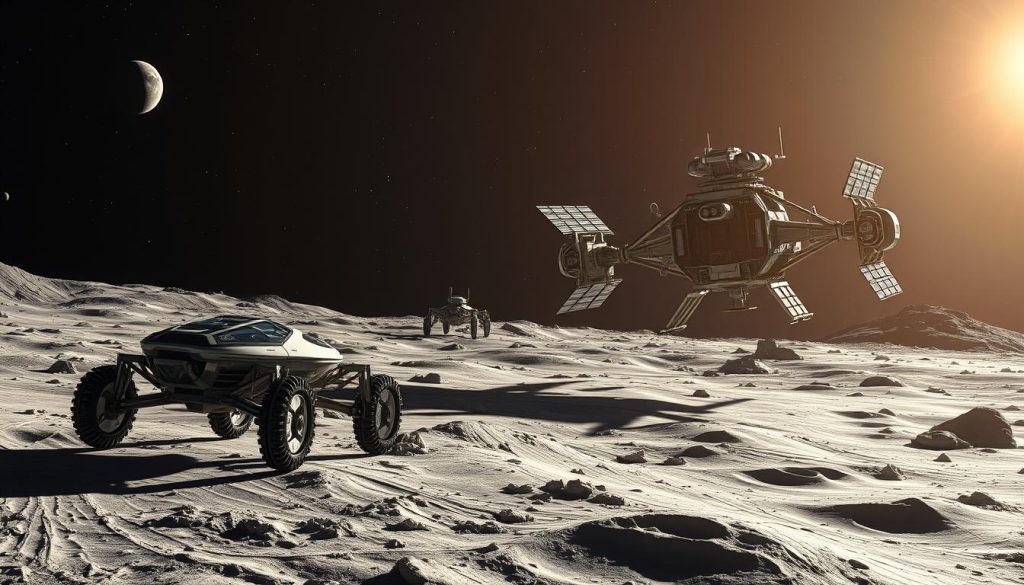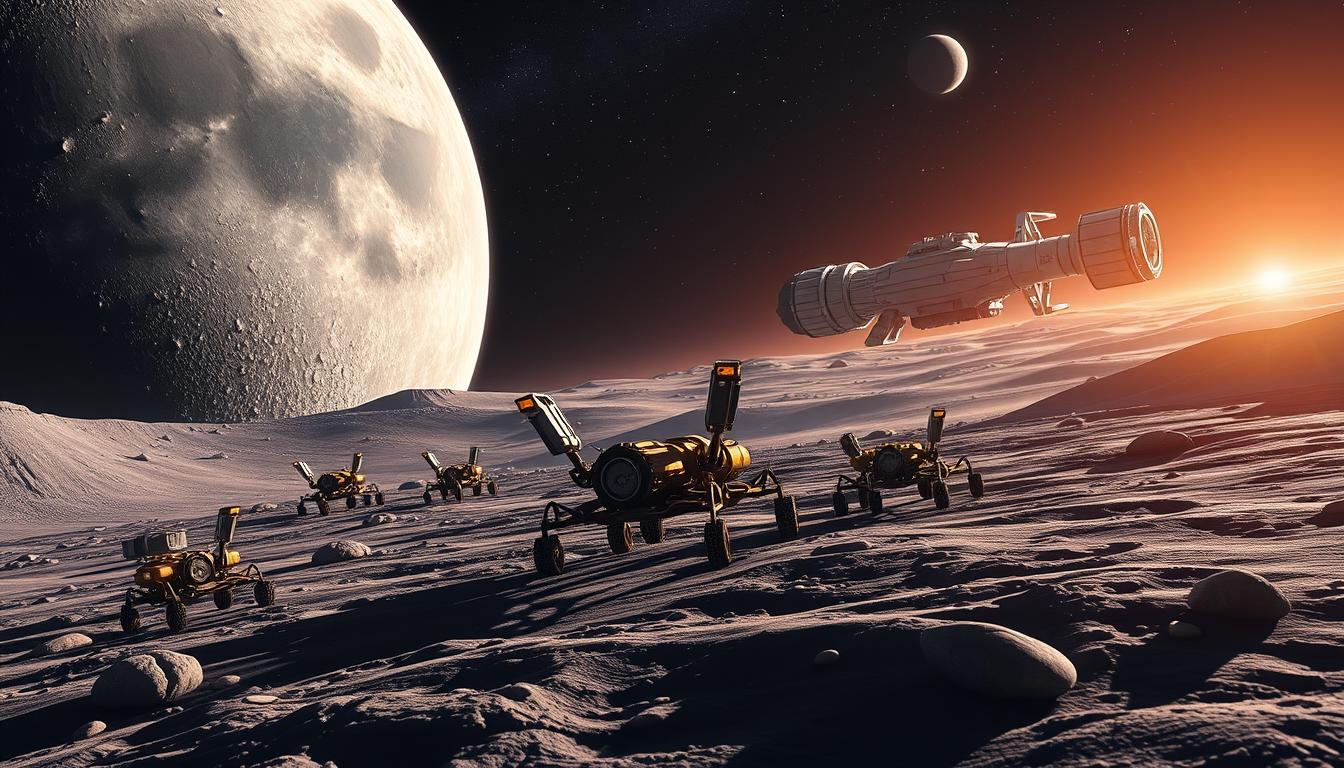The year 2025 is going to be big for space travel. We’re looking forward to uncrewed lunar visits and the first private space station. With new tech, we’re seeing more missions to the moon and beyond.
This article will tell you about the top missions. We’ll look at NASA’s Artemis Program, SpaceX, and others. They’re leading the way for space travel.
Key Takeaways
- 2025 will see a dramatic increase in new space missions.
- The planned uncrewed lunar visits are set to reach around 44,000.
- The launch of the first private space station is an industry milestone.
- Innovative space technology will be essential for the success of these missions.
- The involvement of private companies is reshaping the landscape of space exploration.
The Future of Uncrewed Lunar Missions
The future of space travel is exciting. The NASA Artemis Program is key in making the Moon interesting again. It’s getting ready for humans to go back by studying the Moon first.
The Artemis I mission is a big step. It’s working on new tech and skills needed for space travel.
NASA’s Artemis Program and Future Lunar Exploration
The Artemis Program wants to do more than just land humans on the Moon. It plans to send uncrewed missions to explore the Moon’s surface. This will help us learn more about the Moon and its resources.
NASA is working with other companies to explore the Moon. This is a new way of working together in space.
Companies Involved in Lunar Missions
Many companies are helping with uncrewed lunar missions. Firefly Aerospace, Intuitive Machines, and Astrobotic are some of them. They are working with NASA to send important tools to the Moon.
These companies are helping us learn more about the Moon. They are getting ready for humans to explore the Moon again.
Breakthroughs in Commercial Lunar Payload Services (CLPS)
Commercial Lunar Payload Services has started a new chapter in exploring the Moon. Companies like Firefly Aerospace and Intuitive Machines are leading the way. They bring new tech and science tools to the Moon.
Firefly Aerospace’s Blue Ghost Mission
Firefly Aerospace’s Blue Ghost Mission is set to launch in mid-January 2025. It’s part of NASA’s push to explore the Moon with private companies. The mission will send ten NASA payloads to the Moon’s surface, near Mons Latreille.
The Blue Ghost will study the Moon’s environment in detail. This will help us learn more about the Moon’s geology.
Intuitive Machines’ Moon Landing Plans
In February 2025, Intuitive Machines will send its IM-2 mission to the lunar south pole. This mission aims to land and study the Moon’s surface. It will look at the Moon’s regolith, or soil, for volatiles.
Finding out about these volatiles is key for future Moon missions. It could help find resources needed for living on the Moon.

SpaceX’s Pivotal Role in Lunar Exploration
SpaceX is a big name in exploring the moon. It’s working on a cool spacecraft called Starship. This spacecraft will help with many missions to the moon and even Mars.
Starship Testing: A New Era for Deep Space Missions
Soon, SpaceX will start testing Starship. These tests will help a lot with exploring the moon. They will check if Starship can carry what’s needed for bases and trips to the moon.
- Verifying launch and landing mechanisms
- Testing payload capacity and deployment strategies
- Evaluating performance in various space environments
These tests are very important. They will make sure Starship is ready for deep space missions. It’s designed to be strong and reusable, making trips to space cheaper.
SpaceX’s Collaborations with NASA
SpaceX works closely with NASA. They’re helping with the Artemis program. This program wants to have people living on the moon for good.
| Objective | Description |
|---|---|
| Human Landing System | Use Starship as the lunar lander for astronauts. |
| Logistics Transport | Bring supplies and gear for living and exploring on the moon. |
| Technological Innovation | Use new tech for better propulsion and life support for long trips. |
This partnership makes NASA’s moon missions better. It also shows SpaceX’s big goal to explore space more. With new tech and better ways of working, SpaceX is changing how we explore the moon.
The Launch of the First Private Space Station
The first private space station, Haven-1, is coming soon. Vast company is launching it in August 2025. It will be a place for humans to live and work in space for a long time.
This is a big step for space travel. It will help us learn more about space and do cool things there.
Introduction to Haven-1 by Vast
Haven-1 is a big step for private space travel. Vast company made it to help with space research. It can carry many things and work with different groups.
This station is very flexible. It can help with lots of space projects. It’s a place where people can work together on space stuff.
Human Spaceflight Missions to Private Stations
Haven-1 will make space travel even better. Astronauts will go on missions to see what private stations can do. This is a big deal for space travel.
It shows that private companies are playing a big role in space. It also means we might see more stations and partnerships in the future.
| Aspect | Description |
|---|---|
| Launch Date | August 2025 |
| Company | Vast |
| Station Type | Commercial Space Station |
| Key Features | Independent crewed facility |
| Primary Focus | Research and Exploration |
| Target Population | Astronauts and Researchers |
NASA’s SPHEREx Mission and Its Significance
The NASA SPHEREx mission is set to launch in February 2025. It’s a big deal in space exploration. This mission will use new tech to study the universe’s start through galaxy mapping.
It will look at near-infrared light to learn more about the universe. This will help us understand big cosmic events better.
Exploring the Origins of the Universe
The SPHEREx mission wants to learn about the universe’s start. It will study over 450 million galaxies. This will help us see how stars and galaxies are spread out.
It will also find out about water and organic molecules in new stars. This will help us understand how galaxies grow and change. It will answer some big questions in space.
How SPHEREx Will Map Galaxies
The mission will use special tech to map many galaxies. It will look at near-infrared light to see through cosmic dust. This will show us hidden parts of the universe.
This is a big step in understanding space. The mission will give us important data. This data will help us learn more about the universe in the future.
| Feature | Details |
|---|---|
| Launch Date | February 2025 |
| Primary Goal | Investigate the origins of the universe |
| Galaxies Mapped | Over 450 million |
| Stars Mapped | More than 100 million stars in the Milky Way |
| Observational Focus | Near-infrared light |
| Targets of Interest | Water and organic molecules in stellar nurseries |
Expected Innovations in Low Earth Orbit
New missions and tech are changing research in low Earth orbit. The ESA Space Rider Mission is a big step. It shows how reusable spacecraft can help us learn more about science.
ESA’s Space Rider Mission
The ESA Space Rider Mission is coming in 2025. It’s a big deal for space research. This reusable spaceplane will help scientists do cool space experiments.
Being able to reuse it is a big plus. It will save money and let us do more missions.
Research and Experiments in Microgravity
Microgravity is special for research. It lets scientists study things in a way Earth can’t. The Space Rider Mission will help us learn more about this.
Scientists will do many space experiments. This will help us understand materials and biology better. It’s a big step for science.
New Reports Claim Nintendo Switch 2 Will Have PS4 Pro Power, With A Catch
Exciting rumors are buzzing about the Nintendo Switch 2. It might have power like the PS4 Pro. This makes gamers and tech fans very curious.
Nintendo has sold over 146 million Switch units. But, its unique look and games are what make it popular. It shows that being powerful isn’t everything.
Gaming Hardware Developments and their Impact on Space Tech
Gaming and space tech are getting closer. Better gaming hardware could help space tech too. It might make space missions more advanced.
This could lead to new things in both gaming and space. It’s a cool idea.
Comparisons Between Gaming and Space Innovation
Gaming and space tech share some things. They both need fast and strong parts. The move from PS3 to PS4 shows how fast things can change.
As we get better at making these parts, gaming and space might learn from each other. It’s a win-win situation.
| Aspect | Nintendo Switch 2 | PS4 Pro |
|---|---|---|
| Expected Sales | Projected strong sales post-launch | Over 30 million units sold |
| Hardware Power | Comparable to PS4 Pro | Significant leap from PS3 |
| Unique Selling Point | Stylized visuals and exclusive games | High performance for AAA titles |
| Market Position | Third best-selling system | Strong contender in the market |
Conclusion
Looking ahead to 2025, we see big changes in space exploration. Both governments and private companies are working hard. They plan to send many missions to the moon.
NASA’s Artemis program and companies like Firefly Aerospace and Intuitive Machines are leading the way. These missions will help us learn more about our moon. They are also a step towards exploring more of our solar system.
Commercial space stations, like Vast’s Haven-1, are also changing how we see space. They offer a new way for humans to live in space. This could lead to new research and even homes in space.
These plans show how technology and space are becoming more connected. They make dreams of space travel a reality. It’s exciting to think about what the future holds.
The missions and tech we’re expecting will help us understand the universe better. 2025 is a big year for space exploration. It brings new chances and ways to explore space.


